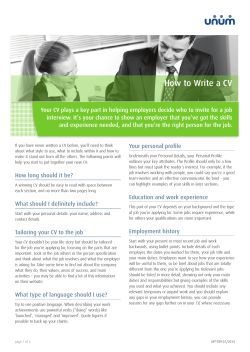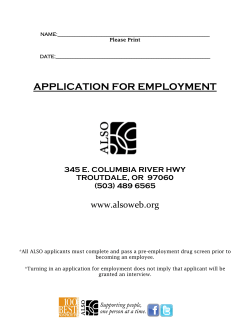
�� V e e r.c o m /W e s te n d 6 1 P h o to g ra p h y
©Veer.com/Westend61Photography 03 | 2015 The Magazine of WorldatWork © ® Integrating well-being into your private exchange health-care program can lead to productive, healthy and focused employees. Saving Money Isn’t the Only Consideration for a Healthy, Productive Workforce The private health insurance exchange environment has created opportunities to transform employers’ plan designs in ways that positively impact employees and their well-being while yielding likely cost savings for employers. However, many of the available multicarrier private exchange offerings are letting this opportunity pass them by for a slightly altered version of the health-plan status quo. Health is not simply the absence of disease, but “the complete physical, mental and social well-being of an individual” according to the World Health Organization. This broader, more holistic definition of health should encourage employers to expand the dimensions addressed by their current health management programs. By Dr. Bruce Sherman and Scott Rabin, Buck Consultants at Xerox © 2015 WorldatWork. All Rights Reserved. For information about reprints/re-use, email copyright@worldatwork.org | www.worldatwork.org | 877-951-9191 march 2015 workspan | 45 Employers should ensure that they have a clear set of outcome measures that provide evidence of When benefits plans capture these aspects of well-being, employees are likely to perform better at work and be more productive. This all-encompassing approach can ultimately lead to more effective health-care cost containment as individuals are supported to become more engaged in their own health management. One way that employers can embrace well-being for their employees is by selecting a private exchange with a well-being program that is fully integrated with other benefits services — one that yields measurable outcomes and addresses all aspects of health (physical, mental and social) and financial well-being. And while companies can certainly integrate well-being using other types of programs, this article focuses on the integration of well-being with private exchanges. Well-Being Operationalized Well-being programs address all areas of physical, mental, social and financial health. A hierarchy of personal needs should be addressed before individuals can more comfortably attend to their physical health. For example, significant financial stress may well be a higher priority for an individual to address than exercise. Employers can’t ignore employee financial concerns while promoting an exercise program, expecting those concerned employees to participate. That’s why the focus is not wellness, which largely implies physical health considerations, but well-being, which is a considerably broader approach. 46 | workspan march 2015 The extent of well-being program offerings in private exchanges varies substantially as does the level of program integration within the broader exchange offering. When surveying private exchange features, it is important to appreciate that some exchanges have well-being as a core offering. With the growing recognition that high health-care deductibles can contribute to financial stress, tactics to support financial well-being have become increasingly recognized as a source of employer value as a means to keep employees focused on their work and not distracted by personal financial concerns. Growing numbers of employers have formally incorporated financial literacy programs into their benefits offerings, but for many, such programs are siloed and don’t necessarily engage those who may have the greatest need. How Is Well-Being Integrated into the Exchange? When considering a private exchange offering, employers should assess the level of integration of all available programs within the exchange offering. Are the programs strategically integrated to minimize redundancy and ensure that a comprehensive scope of relevant well-being services are offered to the appropriate individuals? Is there operational integration, such that referrals between programs are easily and consistently facilitated? Is there comprehensive data integration, such that aggregate reporting across offerings provides greater health management insights than siloed individual program reporting? Is there a systematic approach to reporting that provides actionable insights for both the exchange vendor as well as the employer? Is the value of the provided programs quantified in a credible manner? Below are additional areas for employers to consider as a part of the selection process: ❙❙ Measurable outcomes: Employers should ensure that they have a clear set of outcome measures that provide evidence of well-being success. These should include program participation and satisfaction rates as early indicators of engagement; measures of improvement in health and well-being status as intermediate indicators; and favorably trending engagement, cost and/ or productivity measures as lagging indicators of program impact. Employers should ask for standard well-being reporting when evaluating exchange options to ensure that these components are included. ❙❙ Personalized elements: Substantial evidence supports the use of personalization to foster individual engagement in health and well-being management programs. This is particularly important given that individuals have different well-being concerns and will benefit more from an offering that can be targeted to meet their individual needs. Employers considering private exchanges should inquire as to the level of personalization and request A hierarchy of personal needs should be addressed before individuals can more comfortably attend to their a demonstration of any consumerfacing vendor software before making a purchasing decision. ❙❙ Proactive and preventive outreach: Employers considering private exchanges should ensure that the offering provides fully integrated health and well-being benefits services. Properly integrated, these offerings provide benefits enrollees with a consistent, proactive and engaging platform to achieve quantifiable — and significant — results. The Role of Technology Technological advancements in recent years have provided unparalleled opportunities for the transformation of the delivery system, facilitating more efficient and effective interaction among health plans, providers and consumers. Examples include smartphone applications for tracking of health-related measures including diet and physical activity. Personal health records centralize health-related data and make it readily accessible for individuals when visiting multiple health-care practitioners. Secure email communication platforms facilitate interaction between patients and their clinicians. The Payoff for Investing in Your Workforce For companies, workforce human capital is a vital organizational asset. 48 | workspan march 2015 However, when benefits decisions are made, cost is too often the primary (if not sole) concern. When an employer looks at a piece of equipment, for example, consideration is given to how the cost of the equipment compares with the expected incremental increase in revenue generation. In contrast (and perhaps paradoxically so), when shopping for benefits, employers often limit their evaluation to the line-item cost of the program, neglecting the impact that the offering may have on workforce performance. There is value in investing in the overall health and well-being of the workforce. Healthy workers have lower health-care costs, are absent less often and perform better at work than their unhealthy counterparts. Using cost-shifting tactics as a means to reduce health-care costs may have unintended consequences, including less effective chronic condition management, increased financial stress as individuals deal with high out-of-pocket costs, and less optimal work performance. But when viewed as an asset, strategic investments in workforce health have the potential to improve employee well-being, foster employee engagement, and enhance workforce and business performance. Employers entering the private exchange market have an opportunity to change the way they think about their health benefits strategy. While cost containment is a fundamental objective, an opportunity exists to implement an exchange strategy that helps to optimize workforce well-being and performance. Improperly implemented, costcontainment tactics risk underuse of many appropriate health-care services. As a result, health-care costs may fall — and to the detriment of individual health, well-being and performance. Dr. Bruce Sherman is medical director – population health management at Buck Consultants at Xerox in Cleveland. He can be reached at bruce.sherman@xerox.com. Scott Rabin is general manager for private health exchange solutions at Buck Consultants at Xerox in Los Angeles. He can be reached at scott.rabin@xerox.com. resources plus For more information, books and education related to this topic, log on to www.worldatwork.org and use any or all of these keywords: ❙❙ Private exchanges ❙❙ Health care ❙❙ Health-care+exchanges+well-being.
© Copyright 2025
















